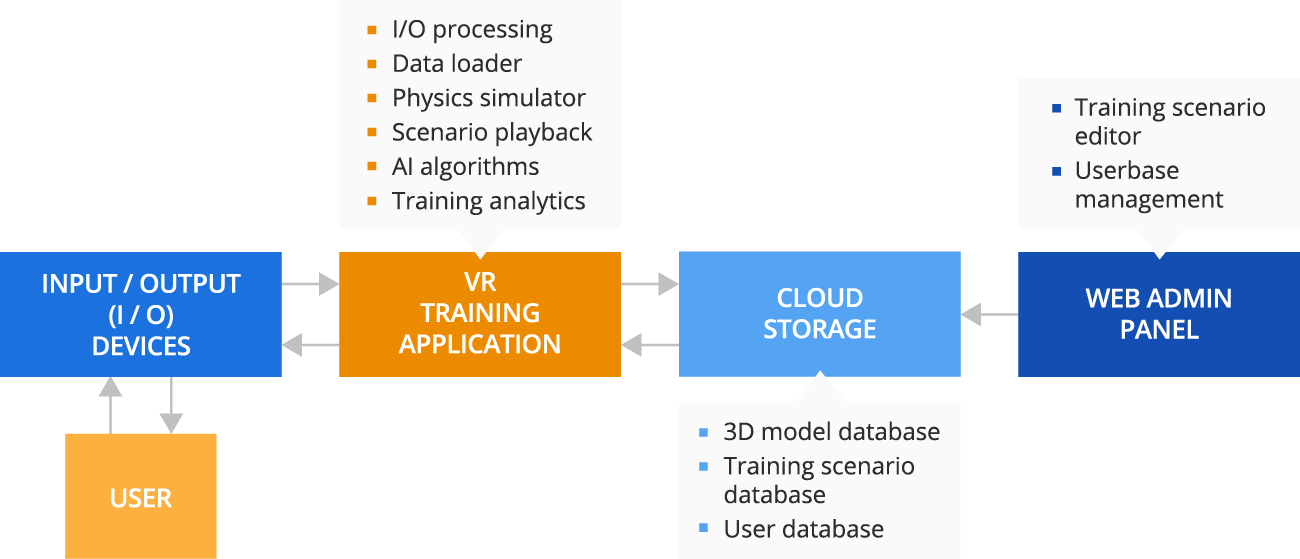Virtual Reality for Training: Use Cases, Architecture, Challenges, and Costs
With 35 years in software development and 28 years in 3D modeling, ScienceSoft provides VR consulting and virtual reality app development services.
Virtual Reality for Training: The Essence
VR software for training is aimed at improving learning engagement by 3.75 times compared to classroom learning, raising trainee on-the-job accuracy by 40%, as well as reducing training time by up to 80% and costs by 52%.
The Market of Virtual Reality for Training
In 2020, virtual reality (VR) training was the largest sector in the AR/VR market with 12.1% ($1.3 billion) of gross profit. The figure is expected to grow at a 61.8% CAGR by 2023, as VR continues to be the driving force of cost-effective and risk-free training for all industries.
How VR for Training Works
VR training solution architecture

The architecture of VR training software includes 3 key elements:
A web administration panel
that enables editing of training scenarios and allows adding, deleting, and editing profiles of VR software users.
Cloud storage
with databases containing 3D visual assets, training scenarios, and user profiles.
A VR training application
that includes multiple modules, responsible for:
- Processing of input data received from motion and touch controllers and/or haptics gloves.
- Generating visual, audial, and sensory (if required) feedback.
Features of virtual reality training solutions
Training program
– sets of virtual reality training scenarios, created and modified by an instructor.
Performance analytics
– automatic analysis and assessment of a trainee’s progress.
AI-controlled virtual characters
– for communication training with realistic virtual customers or patients.
In-app video streaming
– for playback of video guides or past sessions recordings in the VR environment.
Multi-user sessions
– for group training or training with an instructor.
Industry use cases of VR for training
Education
VR support of traditional training in educational facilities. Improves engagement in the learning process by 3.75 times over classroom learning.
Healthcare
VR software for immersive medical training, from patient communication skills learning and emergency drills to medical procedure and surgery simulations. Raises trainees’ precision and accuracy in medical manipulations by 40% compared to the trainees who attend non-VR training courses.
Retail
VR for store employee training to enhance soft skills and prepare for stressful conditions (e.g., Black Friday sales). Allows saving up to 80% of the time required in regular retail training programs.
Automotive industry and aviation
VR corporate training systems to gain high proficiency in vehicle maintenance and control. Enabling safe simulation of challenging vehicle operation situations, such systems eliminate all corporeal risks and cut training costs by 52%.
Manufacturing and construction
VR software for industrial job training. Teaches to operate industry-specific equipment and provides effective safety training for hazardous workplaces while ensuring 4x more effectivity over non-VR learning.
A Success Story of VR for Training
ScienceSoft’s team of three 3D model designers and two C++ engineers has developed a VR training solution for gas station employees. The solution features a virtual copy of a gas station with more than 100 elements of the fuel communication system represented as highly detailed 3D models, which attendants in training can closely inspect and interact with. VR software also displays textual tips next to each equipment part, revealing their purpose and specifics of use.
After introducing the VR training solution to employees, the chain of gas stations managed to shorten onboarding time significantly, which resulted in an increase in revenue.
Typical Technology Stack for VR Training Solutions
Challenges of Virtual Reality for Training
Challenge #1
Trainees can question the privacy of their training progress data.
Challenge #2
Instructor-free training courses are less flexible and effective for trainees.
Costs of Implementing a VR Training Solution
Talking from ScienceSoft's experience, we estimate the starting cost of VR training software as $150,000. For each VR project, we take into account the following factors to calculate a precise cost.
Core cost factors
- Method of acquiring/creating key visuals (Photoshoot, Video shoot, 3D CAD rendering).
- Complexity of training scenarios.
- Number and types of targeted devices.
Additional costs
- Hardware (Tethered HMD: Oculus Rift, HTC Vive, Valve Index; Smartphone-compatible viewers: Google Cardboard, Samsung Gear VR, Google Daydream View; Standalone HMD: Lenovo Mirage Solo.)
- AI development.
- Integrations with:
- Content Management System (CMS).
- Learning Management System (LMS).
Operational costs
- Cloud services (price depends on the provider’s plan and pricing policy).
VR for Training: Consulting and Development by ScienceSoft
Drawing on 28 years of experience in 3D modeling and over 9 years in eLearning, ScienceSoft is competent in both consulting and development services for virtual reality training software.
VR for training: consulting
- VR concept finalization.
- Long-term release planning.
- Architecture design.
- Planning of integration with a wide range of hardware and software.
- Technology stack definition.
VR for training: development
- UX and UI design.
- 3D model design.
- VR development and quality assurance.
- Integration with various types of hardware and software.
- Continuous support and evolution.
About ScienceSoft
ScienceSoft is a global software development and IT consulting company established 1989 and headquartered in McKinney, TX. We offer VR software development services for multiple domains and industry use cases. Achieving project goals in spite of time and budget constraints, as well as changing requirements, is ScienceSoft's top priority. You set goals, we drive the project to fulfill them.

 Schedule a call
Schedule a call

 Schedule a call
Schedule a call